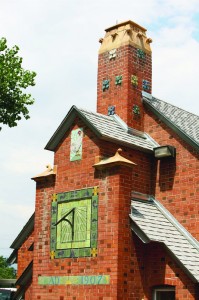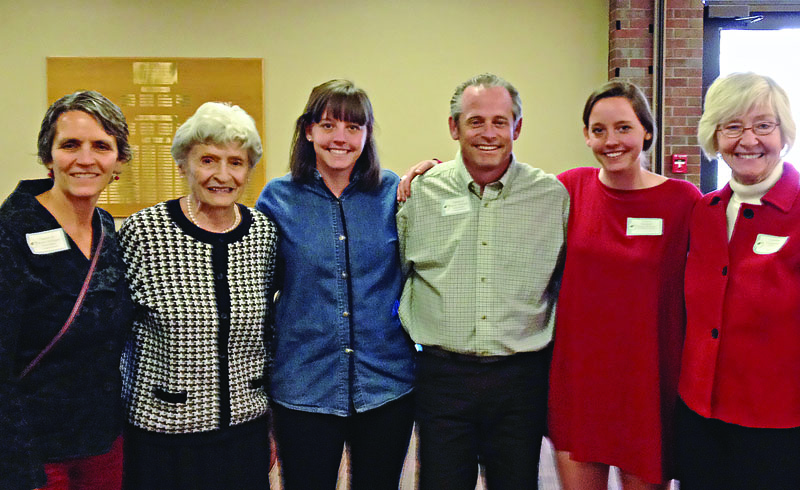The place: Gaylord Hall in Worner Campus Center. The date: April 21, 2015. The occasion: the annual meeting and luncheon of the Woman’s Educational Society. Tables are filled with members, catching up on news, and young women — WES scholars — with their proud families.
Several Woman’s Educational Society scholars, who graduated in May, shared their journeys at the luncheon.
Justine Camacho ’15, an English major from Aurora, Colorado, said “A generous donation from a group of incredible women is the reason I stand before you today.” She was mentored by WES member Rhonda Heschel.
Anna Kisken ’15, a psychology major from Fairbanks, Alaska, applauded her mentor, B Fox, saying “B has been with me from step one.”
MacKenzie Mulligan-Buckmiller ’15, a molecular biology major from Manitou Springs, Colorado, called her mentor, Caroline Vulgamore, a “ray of sunshine.”

Florita Villagrana ’15, at the WES luncheon with her parents Jorge and Florita, found out about CC from her father’s employer. The elder Villagranas grew up in Mexico.
Florita Villagrana ’15, a double major in economics and political science from Denver, said her CC experience had been “four of the most extraordinary years of my life.” That was greatly due to her mentor, Laura Hagler.
They’re the latest in a line stretching back to 1889, when Mary Slocum founded the organization. Wife of CC President William Slocum, she wanted to ensure that finances would not bar any deserving young woman from CC.
“A Quiet Work,” a history of the organization’s first century, quotes Mary Slocum as writing in 1893 that “the most important work of the society seems to me to be creating and spreading of a general interest in the higher education of young women.”
She met with 36 women on April 20, 1889, to form a society “whose special purpose should be to aid the young women in attendance upon Colorado College.”
Those young women, Mary Slocum felt, should exhibit modesty, delicacy, grace, dignity, and reserve. Apparently, those were qualities she carried, along with humor, kindness, and determination.
Mary Slocum was elected president and would hold that office until 1917, when her husband retired from CC.
In 1889, female students lived in boarding houses, whereas male students lived in Hagerman Hall. WES’ first order of business: building a women’s dormitory. WES raised $15,000 through membership dues, bazaars, and lectures.
The dormitory was completed in May 1890 and named Montgomery Hall in honor of Mary Slocum’s family. It was followed by Ticknor Hall in 1898 and McGregor Hall in 1903, both built with support and input from WES.
Those buildings welcomed an increasing number of female students, many of whom needed financial assistance. According to “A Quiet Work,” the society helped 250 students (men were added in 1894) with $18,000 in loans in its first 40 years.
By 1964, the society had given more than $100,000, much of that thanks to bequests and other gifts.
WES projects during its first century included a piano for Ticknor Hall in 1899 and an 18-room house and its conversion to an infirmary from 1935 to 1944.
Two statistics from the annual report revealed at the April 21 meeting: 230 members as of Dec. 31, 2014 and a $3,959,552 market value of the endowment fund as of the same date.
President Jill Tiefenthaler attended the luncheon and spoke about the “rich legacy” the society has bestowed on CC.
WES represents three things I hold dear,” she said. Those are students, connection to community, and strong women. Announcing the $136,500 in scholarships to 21 students in 2014-15, she said, “This is how great legacies live on.”
Almost two months later, the scholars reflected on their experience.
“WES support changed my life in that they allowed me to complete college, plain and simple,” Camacho said. “Whenever I was feeling discouraged or like I didn’t belong, the many luncheons and events assured me that I had earned my place at Colorado College.”
“They definitely made Colorado Springs feel more like a home to me, especially in my first years at school when I didn’t know many people or the community that well. WES was like a safety net of amazing people you knew always had your back,” Kisken said.
Mulligan-Buckmiller talked about how WES made a difference “with all the positivity I received through each member. The lunches with Caroline really allowed me to pause in the midst of a crazy or stressful block and remember the good things that were happening.”
“My CC education was possible thanks to support from people like the WES ladies who believed in my potential. WES also provided a safe environment where I made many friends and felt that I had a network of people who were always there for me,” Villagrana said.
Diane Brown Benninghoff ’68 was at the luncheon that day and later reflected on her long WES membership.
“I feel good about being part of an organization that is devoted to the education of young women at CC. Changing their lives is why we do this, not to change our own.
“One of the most remarkable characteristics of WES is that, since its founding, the women involved are as likely to not be CC alumnae as they are to be alumnae. That these women have ‘adopted’ CC as their own is one of its greatest strengths.”
WES member Shirley Kling Woolley’67 is paying forward what she was given.
“I was a first-generation student when I entered CC in the fall of 1963,” she said. “My WES Scholarship was part of a generous financial aid award, which allowed my parents to provide the same monetary contribution as would have been required if I attended the University of Colorado. We were a middle-class family and didn’t qualify for any aid from a state institution.”
Perhaps Woolley spoke for Mary Slocum and so many others when she said, “I’ve always believed that we don’t do the work of changing the world, but many of our scholars will.”
About the Van Briggle Building Tour
 The Van Briggle Memorial Pottery Building, 1125 Glen Ave., was built in 1907 to memorialize Artus Van Briggle, a celebrated potter who came to Colorado Springs in 1899 and died of tuberculosis in 1904. Colorado College bought the building in 1968 and today it houses Facilities Services.
The Van Briggle Memorial Pottery Building, 1125 Glen Ave., was built in 1907 to memorialize Artus Van Briggle, a celebrated potter who came to Colorado Springs in 1899 and died of tuberculosis in 1904. Colorado College bought the building in 1968 and today it houses Facilities Services.
WES has sponsored tours of the facility since 1997, with proceeds going to its scholarship fund. The 2014 tour raised more than $5,250.
This year’s tour will be 9 a.m.-3 p.m., Saturday, Sept. 12; tickets are $10. Visitors also can tour the nearby Horticultural Art Society gardens, try their skills on a potter’s wheel, and bring one to two pieces for authentication by Van Briggle expert Kathy Honea. Information: (719) 389-7699.
Joining WES
WES welcomes anyone who wants to participate, as long as they share its ideals. Dues start at $25; any amount above that supports WES programs. Information: (719) 389-7699 or www.coloradocollege.edu/WES
